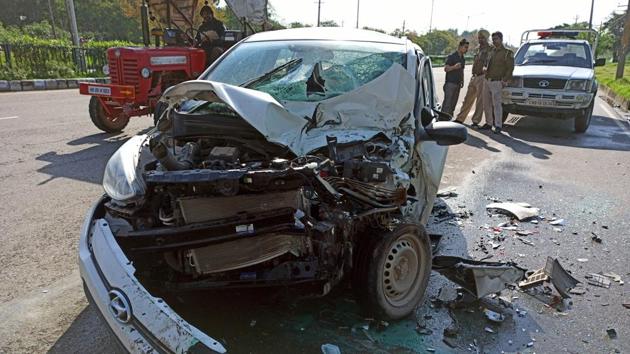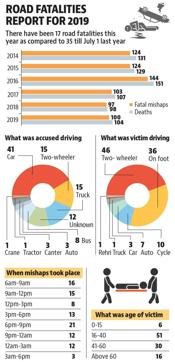Road fatalities: Office transit hours most risky in Chandigarh
The time slot of 6pm-9pm account for 21 of the total 100 fatal accidents while 16 happened between 6am-9am, according to report compiled by the Chandigarh traffic police for 2019
Most fatal accidents in Chandigarh took place between 6am and 9am and 6pm and 9pm, the time slots when people go to or return from work, while almost half of those killed comprise of people in the age group of 16 to 40, making them the most vulnerable.

This has been revealed in the report compiled by the Chandigarh traffic police for 2019.
According to it, there were 104 fatalities in 100 accidents in 2019, a slight increase from 98 deaths in 97 road mishaps in 2018. This year, so far, there have been 17 road fatalities, as compared to 35 till July 1 last year, said deputy inspector general of police (DIG, traffic) Shashank Anand on Friday.
The time slot of 6pm-9pm account for 21 of the total 100 fatal accidents while 16 happened between 6am-9am.
“These are the office transit hours, which is why maximum number of vehicles are on the road, leading to the highest number of fatal accidents,” said deputy superintendent of police (DSP, traffic administration) Kewal Krishan, adding that keeping this fact in mind, more number of traffic cops are deployed during these hours.
Umesh Sharma, professor in the civil engineering department at Punjab Engineering College (PEC) who specialises in traffic and transportation system management, said: “It needs to be seen why are most fatal accidents happening when roads are the busiest, because the trend is usually the opposite. Most people are in a hurry when they’re getting late, which might be causing these accidents.” Sharma said traffic needs to be segregated further and two-wheelers should avoid using the same lane as cars, as this puts them at risk.
With 51 of the total 103 victims, where the age was known, being 16 to 40 years old, DSP, road safety, Jaswinder Singh said: “We are organising frequent awareness sessions for the youth at the Children’s Traffic Park in Sector 23. We have recently been working with delivery boys and educating them to wear helmets for their own safety.”
Jagdish Singh Sarpal, a traffic marshal, said: “Youngsters from villages on the city’s periphery usually don’t follow traffic rules, putting themselves and others in danger. Special nakas need to be set up at the entrances of these villages so that the offenders can be booked and made aware about the importance of following rules.”

Bikers most vulnerable, motorists accused in most cases
According to the report, two-wheeler riders were the most vulnerable, accounting for 46 (44%) of the 104 people killed, though down from 46% in 2018.
Even as the administration is trying to rejuvenate pedestrian paths and cycle tracks under the smart city plan, those on foot or bicycles remain vulnerable, comprising of 34% and 10% victims, respectively, just 1% drop from 2018 figures in both cases.
“The junctions where pedestrian paths meet the main road are not properly designed. Ideally, underpasses must be made for the safety of cyclists and the pedestrians,” said VK Bhardwaj, former chief engineer of the municipal corporation. He also raised concern over footpaths being used for parking vehicles, leaving no space for the pedestrians to walk.
Meanwhile, cars caused the most number of accidents — 41 of 87 cases where the accused vehicle was identified. This was followed by two-wheelers and trucks, in 15 cases each. Road safety activist Harpreet Singh said: “Most car drivers behave as if the whole road belongs to them, due to which such fatal accidents take place. Mostly, two-wheeler riders have to suffer.”
Also, it has come to light that vehicles from Punjab caused the most number of accidents while local population remained most vulnerable. Out of 70 cases in which the vehicle registration number was known, 27 were from Punjab while 22 were from Chandigarh. In the 53 cases where the victim was on a vehicle, 32 were registered in Chandigarh, 14 in Punjab and six in Haryana.
“The emphasis this year will be on bringing the number of fatal accidents down,” said DIG Shashank Anand. “Ever since we have installed six speed radars with display boards in December 2019, there has been no fatal accident at these vulnerable points,” he said, while adding the number has been low this year due to the lockdown as well.
ROAD FATALITIES REPORT FOR 2019
There have been 17 road fatalities this year as compared to 35 till July 1 last year
Year Fatal mishaps Deaths
2019 100 104
2018 97 98
2017 103 107
2016 144 151
2015 124 129
2014 124 131
BOX 2A
What was accused driving
Car 41
Two-wheeler 15
Truck 15
Unknown 12
Bus 8
Auto 3
Canter 3
Tractor 1
Crane 1
BOX 2B
What was victim driving
Two-wheeler 46
On foot 36
Cycle 10
Auto 7
Car 3
Truck 1
Rehri 1
BOX 3
When mishaps took place
6am-9am 16
9am-12pm 15
12pm-3pm 8
3pm-6pm 13
6pm-9pm 21
9pm-12am 12
12am-3am 12
3am-6pm 3
BOX 4
What was age of victim
0-15 6
16-40 51
41-60 30
Above 60 16





